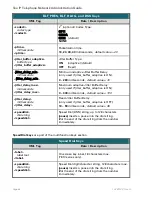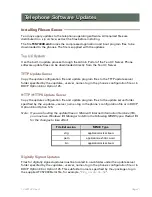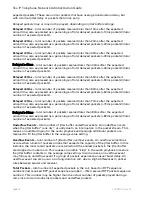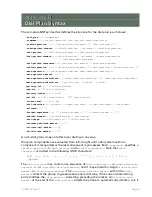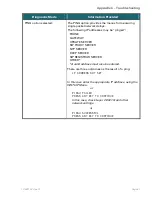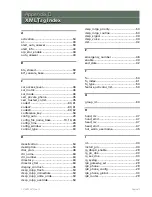
13-280132 Rev. Q
Page 73
Packet statistics are tabulated on a per call, per call appearance basis, and may be viewed
while a call is in progress or after a call is completed. Counts are updated once a second
while a call is in progress. Statistics are saved for the most recent call on each call
appearance. As soon as a new call (inbound or outbound) is initiated, statistics for the
previous call on that call appearance are lost. Expected arrival times for packet delay
calculations are based on the arrival time of the first packet in the call; this reference time is
re-established on underflow and overflow events.
The last 50 packet statistics are saved in the packet history.
Packet statistics are viewed through the Packet Diagnostics menu (
Setup
→
ADMIN
→
DIAG
→
PACKET). Select ACTIVE to view packet statistics for the currently active call, or
HISTORY to view the last 50 recorded packet statistics
For the active call, the codec and jitter buffer settings are displayed first; jitter delay is
displayed first when viewing the history. Press the Right or Left Arrow keys to view
additional statistics.
A packet statistics summary can also be viewed for calls in the call log by selecting DETAIL.
T
T
h
h
e
e
f
f
o
o
l
l
l
l
o
o
w
w
i
i
n
n
g
g
s
s
t
t
a
a
t
t
i
i
s
s
t
t
i
i
c
c
s
s
a
a
r
r
e
e
r
r
e
e
c
c
o
o
r
r
d
d
e
e
d
d
a
a
n
n
d
d
d
d
i
i
s
s
p
p
l
l
a
a
y
y
e
e
d
d
:
:
Codec/Jitter Buffer Settings
–codec and associated jitter buffer selections for the current
call (not shown in the history, but available for the current call and for calls in the call log).
These values are negotiated on a per-call basis.
Jitter Delay
– current “start of call” average jitter buffer setting (playout delay) for either
fixed delay or calculated adaptive delay. The value displayed is based on the jitter buffer
settings of the primary line.
Concealed Packets
– total number of packets that were concealed during audio playback;
also expressed as a percentage of total packets (concealed packets)/(total number of
expected packets). This measurement is done at the audio playback point and correlates to
audible dropouts in the voice path due to lost packets, packets received but delayed
beyond the jitter buffer playback time, or jitter buffer underflow (no packets in the buffer).
During packet concealment, the last received packet is replayed at a reduced level to
minimize the audio interruption. Silence is played if multiple packets must be concealed.
Lost Packets
– total number of expected packets that were not received; also expressed as
a percentage of total packets (lost packets)/(total number of expected packets). Lost packets
are computed by comparing the expected packet count (based on RTP packet sequence
numbers) to the count of actual packets received. Lost packet counts are a result of network
performance and cannot be improved by local jitter buffer settings.
Lost packets = (last RTP sequence number - first RTP sequence number) - number of
packets received.
Not Delayed
– total number of packets received earlier than 10ms after the expected arrival
time; also expressed as a percentage of total packets (not delayed packets)/(total number of
A
A
A
p
p
p
p
p
p
e
e
e
n
n
n
d
d
d
i
i
i
x
x
x
A
A
A
V
V
V
i
i
i
e
e
e
w
w
w
i
i
i
n
n
n
g
g
g
P
P
P
a
a
a
c
c
c
k
k
k
e
e
e
t
t
t
S
S
S
t
t
t
a
a
a
t
t
t
i
i
i
s
s
s
t
t
t
i
i
i
c
c
c
s
s
s
Summary of Contents for 4101
Page 6: ...Teo IP Telephone Network Administration Guide Page 6 13 280132 Rev Q ...
Page 16: ...Teo IP Telephone Network Administration Guide Page 16 13 280132 Rev Q ...
Page 18: ...Teo IP Telephone Network Administration Guide Page 18 13 280132 Rev Q ...
Page 23: ...XML Configuration Files 13 280132 Rev Q Page 23 ...
Page 24: ...Teo IP Telephone Network Administration Guide Page 24 13 280132 Rev Q ...
Page 70: ...Teo IP Telephone Network Administration Guide Page 70 13 280132 Rev Q ...
Page 72: ...Teo IP Telephone Network Administration Guide Page 72 13 280132 Rev Q ...
Page 86: ...Teo IP Telephone Network Administration Guide Page 86 13 280132 Rev Q ...




